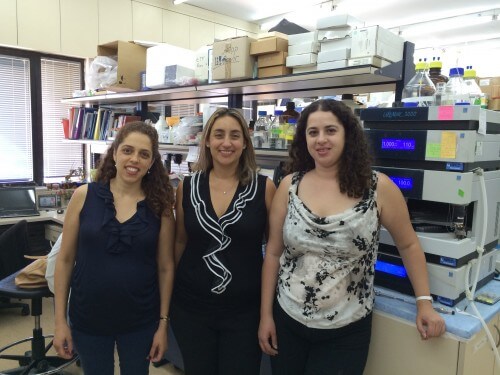The innovative method can be used in the future for personal treatment customized to the patient and the specific tumor that has formed in his body

Prof. Ronit Sachi-Painero and doctoral students Hamda Bevor-Cohen and Ella Markovski from the Department of Physiology and Pharmacology at the Tel Aviv University School of Medicine have developed a new treatment for cancerous tumors that combines two advanced approaches: an effective and synergistic 'cocktail' of two chemotherapy drugs, delivered precisely to the tumor site using a nanometer drug carrier. The researchers demonstrated in their study that the synergistic treatment they developed is more effective and less toxic than the chemotherapy treatments accepted today - including treatments that combine two or more drugs.
The groundbreaking study was selected by the editor of the journal: Journal of Controlled Release as a lead article, and will appear on the cover of the August 2014 issue along with an editorial.
As part of the study, the researchers sought to create an optimal combination between two well-known drugs used to treat cancer patients: the anti-cancer antibiotic doxorubicin (DOX) and the chemotherapy drug paclitaxel (PTX). "In the first step, we wanted to determine the optimal ratio between the two drugs, which would allow them to act together in maximum synergy," explains Prof. Sachi-Painero. "We tested this according to three criteria: differences between the mechanisms of action, the levels and type of toxicity, and the resistance mechanisms that the tumor cells develop in response to each of the drugs. Based on these three characteristics, we were able to determine an exact synergistic ratio, which means maximum efficiency and minimum toxicity."
But the researchers were not satisfied with that. "Even today, it is common to combine drugs to improve cancer treatment, but the problem is that the strength of the treatment is greatly impaired because the drugs do not reach the tumor at the same time," says Prof. Sachi-Painero, "in scientific terms it can be said that each of the drugs It has its own pharmacokinetic profile, which determines how and when it will reach its destination."
To solve the problem, the researchers looked for a nanometer drug carrier that would attach to the two drugs, lead them together to the tumor and release them at the same time, in exactly the right place. "It's like putting several passengers in one taxi, and dropping them off at the same address," explains Prof. Sacchi-Painero. "Everyone arrives at the same destination, at exactly the same time."
under the radar
The drug carrier chosen for the purpose of the study is a polymer of glutamic acid (PGA). The researchers were able to connect the two drugs to it, and injected the combined structure (PGA-PTX-DOX) into mice in a breast and ovarian cancer model. The smart nanometer 'missile' launched in this way was designed to pass inside the body 'under the radar', without causing damage to healthy tissues. Only when the polymer reaches the site of the tumor, it breaks down (degrades) - under the influence of a certain enzyme that is more pronounced in cancerous tumors - and releases the drugs at the same time, exactly where they are needed.
"Our findings showed that the new treatment is significantly more effective and safer compared to treatment with the same drugs at the same doses when given separately," says Prof. Sacchi-Painero. "This is the first study to systematically demonstrate the benefits of an integrated nanomedical model for the treatment of cancerous tumors." According to her, it is a modular platform, which can adapt to a wide range of drugs and drug combinations. For example, the drug carrier can carry a combination of chemotherapy drugs, which attack the cancer cells, with drugs that harm the tumor's environment - stopping the development of the blood vessels that feed it, and/or curing inflammations that occur there. And what's more: the innovative method can in the future be used for personal treatment, precisely adapted to a specific person and the specific tumor that has formed in his body.
"Today we continue our research in the laboratory, perform evaluations and constantly improve the method with the help of tissues from tumors taken from patients," says Prof. Sachi-Painero. "The platform we developed has tremendous potential, and its possible applications are almost endless."

2 תגובות
The drug carrier chosen for the purpose of the study is a polymer of glutamic acid (PGA).
They managed to connect the two drugs to it, and injected the combined structure (PGA-PTX-DOX) into mice in a breast and ovarian cancer model. The smart nanometer 'missile' launched in this way was designed to pass inside the body 'under the radar', without causing damage to healthy tissues.
Is it connected to SIRNA? Does it affect angiogenesis? And so it is shown
If so - I would like to know how?
Aalek innovative research, this cartology should be closed.